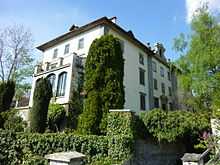Fürstenau, Switzerland
| Fürstenau | |
|---|---|
 | |
| Country | Switzerland |
| Canton | Graubünden |
| District | Hinterrhein |
| Coordinates | 46°43′N 9°26′E / 46.717°N 9.433°ECoordinates: 46°43′N 9°26′E / 46.717°N 9.433°E |
| Population | 367 (Dec 2012)[1] |
| - Density | 278 /km2 (720 /sq mi) |
| Area | 1.32 km2 (0.51 sq mi)[2] |
| Elevation | 650 m (2,133 ft) |
| Postal code | 7414 |
| SFOS number | 3633 |
| Surrounded by | Almens, Cazis, Pratval, Scharans, Sils im Domleschg, Thusis |
| Website | www.fuerstenau.ch SFSO statistics |
 Fürstenau | |
| Location of Fürstenau
 | |
Fürstenau (Romansh: Farschno) is a municipality in the district of Hinterrhein in the Swiss canton of Graubünden and the smallest town to hold city rights with a market right received from Charles IV, Holy Roman Emperor in 1354.
History
Fürstenau is first mentioned in 1257 as Fúrstenowo and Furstinowe. Originally there were two medieval tower houses or guard towers and a bishop's house in the area that became Fürstenau.[3] The Bishop's summer residence is of course the reason for the city right.
Geography

Fürstenau has an area, as of 2006, of 1.3 km2 (0.50 sq mi). Of this area, 52.3% is used for agricultural purposes, while 32.3% is forested. Of the rest of the land, 9.2% is settled (buildings or roads) and the remainder (6.2%) is non-productive (rivers, glaciers or mountains).[4]
The municipality is located in the Domleschg sub-district of the Hinterrhein district. It consists of the village of Fürstenau and Fürstenaubruck, on the right side of the valley.
Demographics
Fürstenau has a population (as of 31 December 2012) of 367.[1] As of 2008, 8.1% of the population was made up of foreign nationals. Over the last 10 years the population has grown at a rate of 12.5%.[4]
As of 2000, the gender distribution of the population was 49.4% male and 50.6% female.[5] The age distribution, as of 2000, in Fürstenau is; 29 people or 9.3% of the population are between 0 to 9 years old. 16 people or 5.1% are 10 to 14, and 13 people or 4.2% are 15 to 19. Of the adult population, 27 people or 8.7% of the population are between 20 to 29 years old. 51 people or 16.4% are 30 to 39, 36 people or 11.6% are 40 to 49, and 44 people or 14.1% are 50 to 59. The senior population distribution is 25 people or 8.0% of the population are between 60 to 69 years old, 28 people or 9.0% are 70 to 79, there are 33 people or 10.6% who are 80 to 89, and there are 9 people or 2.9% who are 90 to 99.[6]
In the 2007 federal election the most popular party was the SPS which received 32.5% of the vote. The next three most popular parties were the SVP (30.4%), the FDP (27.2%) and the CVP (9.5%).[4]
In Fürstenau about 81% of the population (between age 25-64) have completed either non-mandatory upper secondary education or additional higher education (either university or a Fachhochschule).[4]
Fürstenau has an unemployment rate of 1.85%. As of 2005, there were 11 people employed in the primary economic sector and about 4 businesses involved in this sector. 2 people are employed in the secondary sector and there is 1 business in this sector. 133 people are employed in the tertiary sector, with 15 businesses in this sector.[4]
The historical population is given in the following table:[3]
| year | population |
|---|---|
| 1803 | 107 |
| 1850 | 304 |
| 1900 | 235 |
| 1950 | 253 |
| 1980 | 198 |
| 2000 | 311 |
Sights
Fürstenau has three Swiss Heritage Sites of National Significance.
Heritage sites of national significance
The Haus Stoffel, Oberes Schloss (Upper Castle) and Unteres Schloss (Lower Castle, also known as the Bishop's Castle) are listed as Swiss heritage sites of national significance.[7]
-
Stoffel House
-
Oberes Schloss (Upper Castle)
-

Unteres Schloss (Lower Castle)
Languages
The municipality is predominantly German-speaking, with a small Romansh-speaking minority. As of 2000, 92.3% speaks German, with Romansh being second most common ( 3.2%) and Italian being third ( 1.9%).[4]
| Languages in Fürstenau | ||||||
| Languages | Census 1980 | Census 1990 | Census 2000 | |||
| Number | Percent | Number | Percent | Number | Percent | |
| German | 170 | 85.86% | 243 | 89.66% | 287 | 92.28% |
| Romanish | 13 | 6.57% | 15 | 5.54% | 10 | 3.22% |
| Italian | 10 | 5.05% | 4 | 1.48% | 6 | 1.93% |
| Population | 198 | 100% | 271 | 100% | 311 | 100% |
References
- ↑ 1.0 1.1 Swiss Federal Statistics Office – STAT-TAB Ständige und Nichtständige Wohnbevölkerung nach Region, Geschlecht, Nationalität und Alter (German) accessed 16 September 2013
- ↑ Arealstatistik Standard - Gemeindedaten nach 4 Hauptbereichen
- ↑ 3.0 3.1 Fürstenau in German, French and Italian in the online Historical Dictionary of Switzerland.
- ↑ 4.0 4.1 4.2 4.3 4.4 4.5 Swiss Federal Statistical Office accessed 02-Oct-2009
- ↑ Graubunden in Numbers (German) accessed 21 September 2009
- ↑ Graubunden Population Statistics (German) accessed 21 September 2009
- ↑ Swiss inventory of cultural property of national and regional significance 21.11.2008 version, (German) accessed 02-Oct-2009
| Wikimedia Commons has media related to Fürstenau. |
- This article incorporates information from the equivalent article on the German Wikipedia.
External links
- www.fuerstenau.ws
- Fürstenau, Switzerland in German, French and Italian in the online Historical Dictionary of Switzerland.

